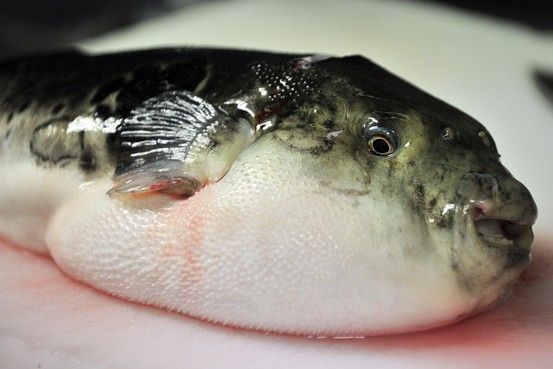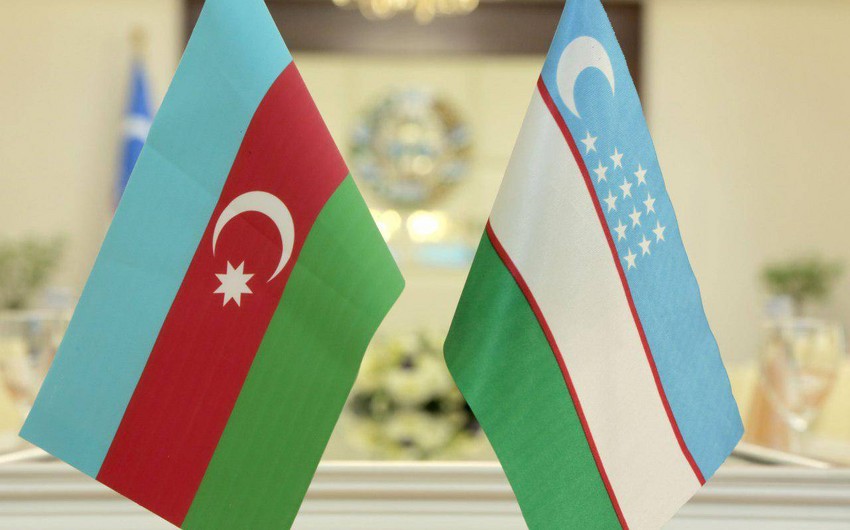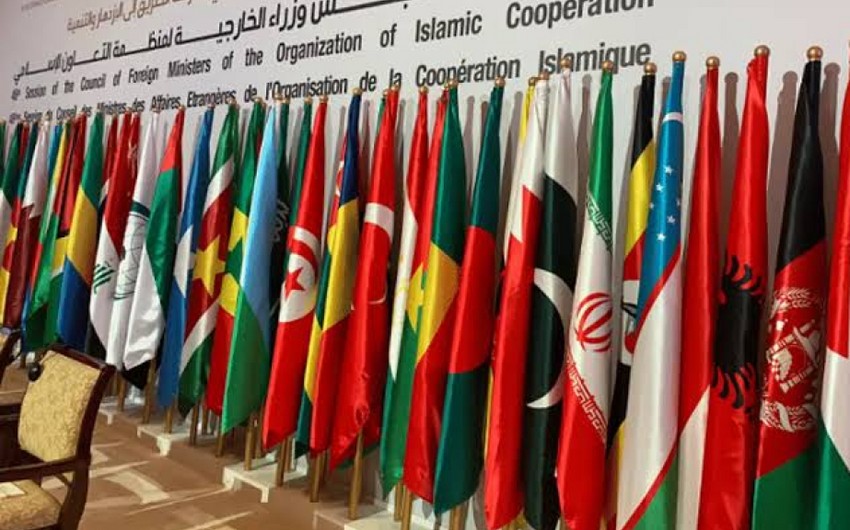The road, hemmed in on one side by empty warehouses and the other by a concrete seawall, ends abruptly in a desolate parking lot. Men step out of their cars and into the darkness, then slip behind the sliding doors of a warehouse. Inside, they huddle under floodlights and wait. A clock on the wall ticks to ten past three in the morning.
“Ready? Ready? Ready?” shouts a man whose arm is covered to the elbow by a black nylon bag. One by one, the men step forward and their hands disappear into the bag.
And so begins a surreal auction in this port city in southwestern Japan. The buyers grip the dealer’s hand, and after a few seconds of secret gesturing felt only by the auctioneer, he yells out the winning bid.
“13,000!” Thirteen thousand yen, or $114, a kilo.
The furtive bidding, a relic of a time when fish traders wore kimonos whose sleeves obscured their hands as they signaled their bids, is part of the insular world of Japanese pufferfish, or fugu, a fish best known for its ability to kill a person in as little as a few hours.
Although deaths are extremely rare, the whiff of danger associated with the fish’s poison is a significant element of the delicacy’s enduring allure in Japanese culture. A kilogram fetches as much as 30,000 yen at the market here, and in the December holiday season, when fugu is particularly popular, a luxury fishmonger in Tokyo can sell up to $88,000 worth of the fish on any given day.
News of poisonings elicits fevered national coverage. When a supermarket in western Japan accidentally sold five packets of the fish without its poisonous liver removed in January, the town used its missile alert system to warn residents.
And now, climate change is adding a new element of risk: Fishermen are discovering an unprecedented number of hybrid species in their catch as seas surrounding the archipelago – particularly off the northeastern coast – see some of the fastest rates of warming in the world.
With pufferfish heading north to seek cooler waters, sibling species of the fish have begun to inter-breed, triggering a sudden increase in the number of hybrid fish. Hybrids are no more dangerous than your average lethal pufferfish. The problem is that they can be hard to distinguish from established species. To avoid accidental poisonings, Japan prohibits their sale and distribution. With the rise of these unclassifiable hybrids, fishermen and fish traders are having to discard a sizable share of their catch.
Kaniya, a seafood-processing company here in Shimonoseki, is one of many in the industry frustrated by the government’s rule to discard such hybrids, considering that most subspecies of pufferfish frequently found in Japan’s northeastern waters have poison in the same organs and can be safely eaten if handled correctly.
“But we have to follow the rules, because if there’s any problems it leads to hysteria,” says Naoto Itou, the gruff patriarch of the company.
Out of 50 or so species of pufferfish found around Japan, 22 of them are approved as edible by the government. Chefs and fish butchers handling pufferfish are specially trained and licensed to remove its liver and reproductive organs, which contain tetrodotoxin, a potent neurotoxin. Confusingly, the location of the deadly neurotoxin differs in certain types of pufferfish; it can sometimes be found in its skin or muscle, as well as its reproductive organs.
Every morning at 8 a.m., Kaniya receives boxes of pufferfish from fishermen in northern Japan. By 9, an experienced fish handler is at his post in an apron and hairnet, sorting as many as seven or eight different groupings of pufferfish at a metal counter.
His bare hands moving quickly, the man picks up one slippery fish after another, holding it up for several seconds, examining its fins and checking for prickles. He pauses on one, turns it to the side, traces its back with his finger, then throws it into the discard pile.
The entire process has a hazmat feel: Workers in latex gloves, white masks and plastic aprons gut the fish and take away the toxic parts and dump them into a lock box. The waste is then collected and incinerated.
Asked why he would continue handling such inherently dangerous fish despite all the headaches surrounding hybrids, Itou points to two of his salesmen hovering nearby, fielding calls from buyers.
“Isn’t it a blessing to be able to handle something customers love and want so much? There aren’t many other fish out there like this.”
SWEEPING IMPACT OF CLIMATE CHANGE
The rise in hybrid species is yet another example of the sweeping impact of climate change on marine creatures, which have undergone a mass migration as water temperatures increase.
Hiroshi Takahashi, an associate professor at the National Fisheries University, first noticed the increase in hybrid pufferfish six years ago. He started receiving calls from a scientific facility on the northeastern coast of Japan’s main island that had buckets of pufferfish it couldn’t identify. In the fall of 2012, nearly 40 percent pufferfish caught in the area were unidentifiable, compared to less than 1 percent studied previously.
“It wasn’t one out of a thousand as it had been in the past; this was on a completely different scale,” he says. To an untrained eye, hybrids are barely discernible. Even veterans in the industry say it’s nearly impossible to tell apart “quarters,” or second-generation offspring of hybrid fish. At the end of June, more than 20 percent of pufferfish caught in a single day off the Pacific coast of Miyagi prefecture, 460 kilometers northeast of Tokyo, were hybrids.
Genetic tests found that the unidentifiable pufferfish were a hybrid of Takifugu stictonotus and Takifugu snyderi. Although they’re close relatives, the T. stictonotus usually swim around the Sea of Japan and the T. snyderi in the Pacific Ocean. Takahashi believes that the T. stictonotus escaped their gradually warming habitat by riding the Tsushima current north and crossing the strait just below Japan’s northern island of Hokkaido to emerge in the Pacific Ocean. There, they bred with their sibling species and multiplied. The resulting hybrid, which has fine spots and yellow-white fins, could pass for either one of its parent species.
A division of Japan’s health ministry in charge of food safety said it began collecting information about the reported increase in hybrid pufferfish in September. Each prefecture has its own tests for issuing licenses to chefs and others, and an industry group has pushed the government to standardize those tests.
Before dawn on a recent weekday, dozens of hobby fishermen throng a deserted dock in the Ohara port, a two-hour drive from Tokyo, to get a chance to catch the creature. They return on the Shikishima-maru around noon, sunburnt and tipsy, carrying white buckets filled with pufferfish.
While the anglers smoke cigarettes and hunch over noodles, Yoko Yamamoto grabs a knife and sits down on a low plastic stool. She works quickly, first striking the fish’s spinal cord, then peeling back its skin to remove its poisonous outer layer. Her son, who captained the boat, then takes over and slashes the fish to its gills to remove its liver and intestines as a moored fishing boat with pastel pink bench seats blasts “Bohemian Rhapsody” from its speakers.
We have to go a bit further now to find them,” says Yukio Yamamoto, 49, crouching next to his mother. “You see all kinds of hybrids now; it’s been this way for the past few years.”
Toshiharu Enomoto, a 71-year-old hobby fisherman, walks over after his lunch and ties a knot in a plastic bag filled with ice and a few pufferfish. Laughing, he talks about the little thrill of the poison. “Some people like it when they feel a bit of tingling on their lips,” he says.
The Japanese have eaten the fish for thousands of years. After it was outlawed by Toyotomi Hideyoshi, a samurai general who unified Japan in the 16th century, peasants continued to eat it in secret and died in droves. The ban on fugu was finally lifted after World War II following years of petitioning by avid fans.
Despite its deadly nature, the fish has an almost comical face and, with its puffed cheeks and open mouth, looks as though it’s perpetually surprised to be so sought after for special occasions.
In Tokyo, high-end restaurants serving pufferfish rely on Otsubo Suisan, a luxury wholesaler at the Toyosu fish market. At the company’s wide stall, Koichi Kushida taps his smartwatch and answers calls on his silver Sony Bluetooth. In the span of an hour, the 34-year-old sells thousands of dollars worth of pufferfish.
“It’s tasty, isn’t it? It’s a luxury and has class; that definitely attracts people,” he says, deftly packing an airtight bag of gutted pufferfish into a golden box. With more hybrids appearing on the market, Kushida personally checks all the fish himself.
“When we hand it to our customers, we have to be sure it’s absolutely safe,” he says. “We can’t have any problems.”









